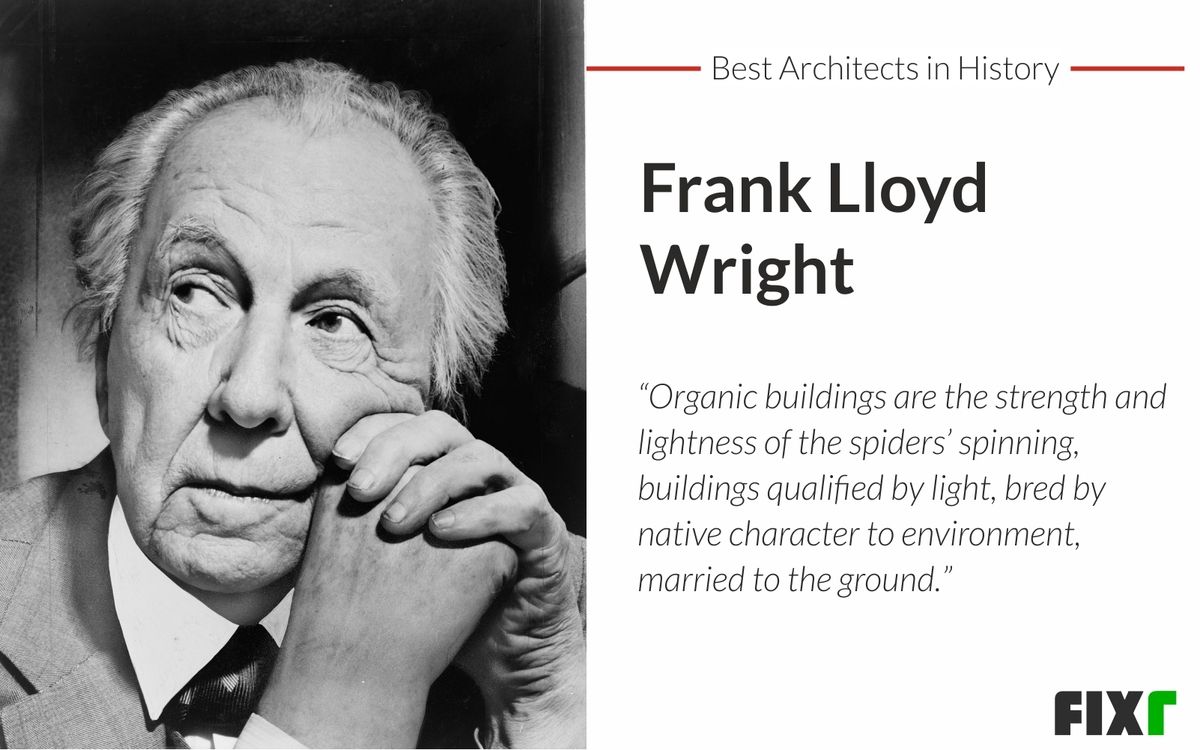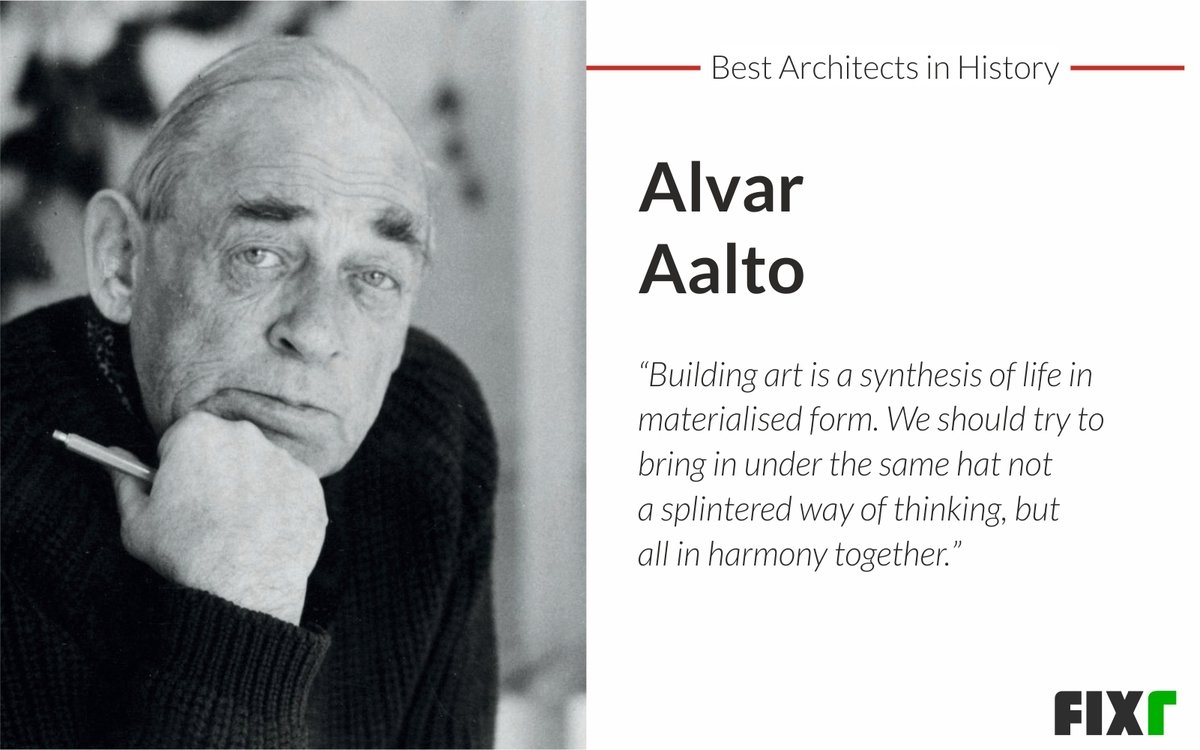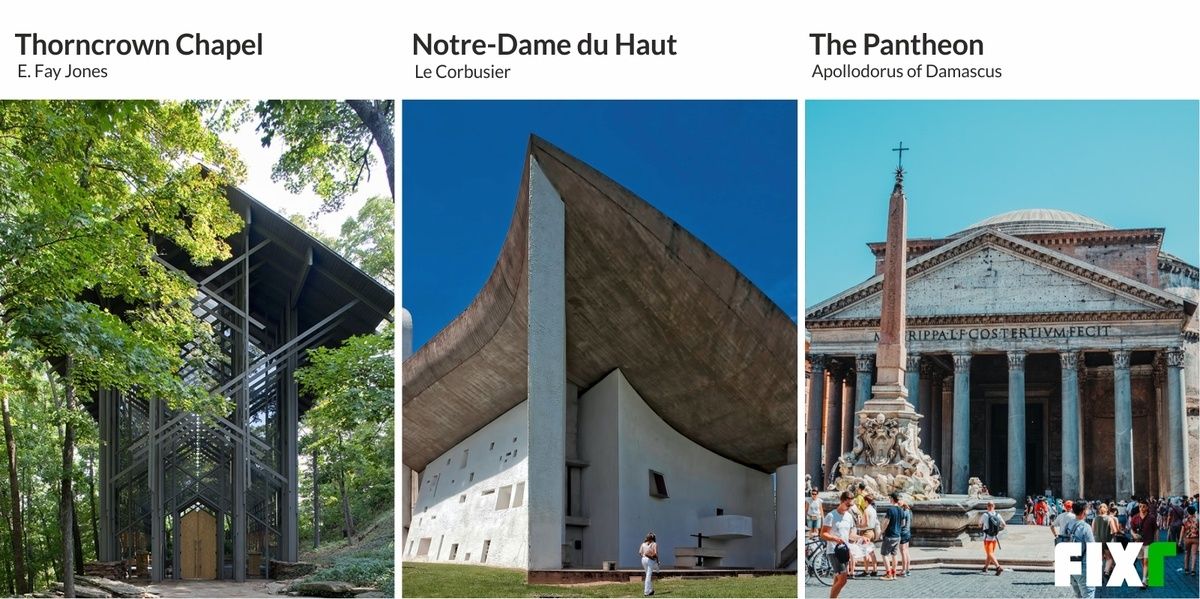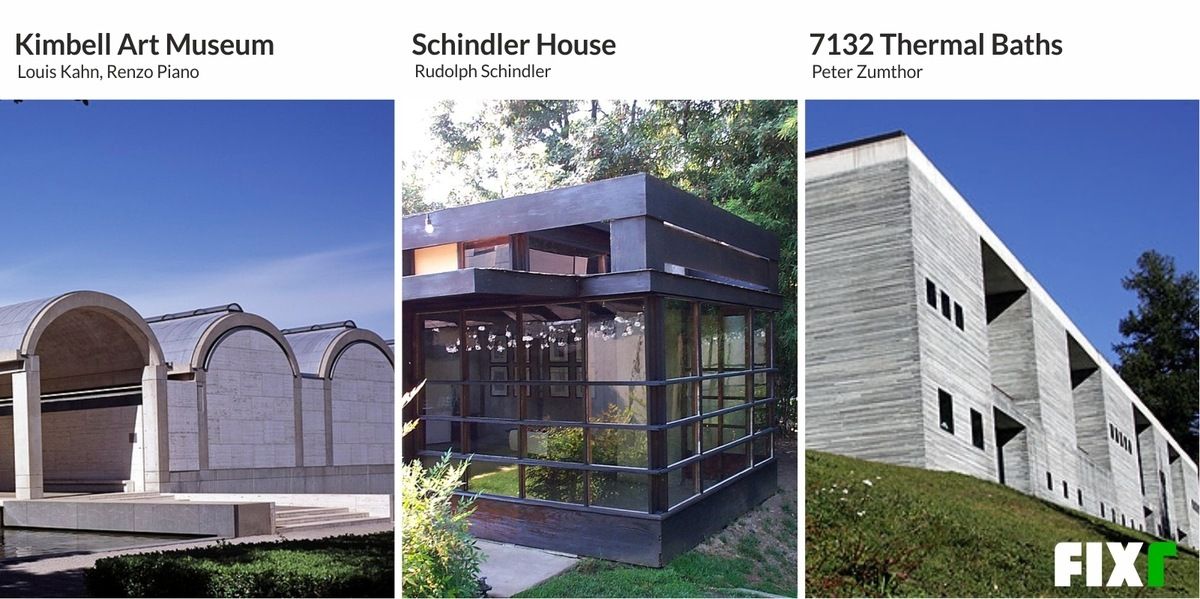Have you ever been on a trip and noticed that certain buildings or structures catch your eye? As you walk through your own city, have you ever taken a step back to observe the buildings that breathe life into your surroundings? It's sometimes easy to look past the structures that surround us, but architects have designed our environments to be both beautiful and functional, and doing this is no easy feat.
The first Monday of every October is World Architecture Day, and to celebrate this year, we surveyed more than 100 American architects to find out their greatest inspirations and influences - those which made them first fall in love with architecture and those which inspired their visions and serve as the foundation of their architectural theories.
In this survey, architects chose architects. Therefore, these rankings are not only based on popularity or legacy, but creativity, innovation, technique, and overall design and engineering acumen. Our survey respondents are accomplished American architects whose choices can provide a deeper insight into the cultural and social influences of American architecture.
Talent that Transcends Time: The Most Popular Architects in History
Our first question was a simple one: who is the best architect of all time? Simple, but very difficult to answer. Choosing a favorite architect is subjective and personal preference will always weigh heavily into the equation. The American architects we surveyed used their own professional experience and their extensive understanding of architectural theory and history to come up with a list of the best architects of all time.
1. Frank Lloyd Wright

There was no doubt about who earned first place-- that crown goes to Frank Lloyd Wright, a man who symbolizes much of what is unique about the American architectural experience. Designing in harmony with humanity and the environment was one of the core hallmarks of his architectural theory, and one which is best demonstrated by his most well known artistic work, the private home Fallingwater (1935). He designed more than 1,000 unique structures over his 70 year career, but he was more than just an architect: he was also an educator and a writer of more than twenty books. The attention he gave his students, disciples, and the readers of his books left an everlasting mark on American architecture.
Why did our survey respondents choose Frank Lloyd Wright?
"His ability to closely integrate architectural form with nature to create a unique individual experience" - Bob Sanderson, Design Collaborative
"Wright embodies a spirit of individualism and creativity that is unparalleled. The breadth and depth of his career had an immense influence on every architect (whether they like to admit it or not!)" - Eric Corey Freed, CannonDesign
"As a child interested in pursuing architecture, I read books written by Wright and studied his buildings top to bottom. One piece of advice that he gave was to create a building in your mind, from every angle, before putting pen to paper. This was written before computers and 3D visualization were perfected. I found his advice to be very useful and follow it to this day. I also love the way he captures light and plays with spaces from the inside out - not too different from the way Michelangelo created his sculptures. It's a different way of thinking but the results can be spectacular. Moving through his buildings is always a unique experience, and Wright was way ahead of his time." - Richard Kaufman, The Kaufman Collaborative Architects
2. Le Corbusier

Second place was no surprise: internationally-minded Le Corbusier, architect of the people. Born Charles-douard Jeanneret in French-speaking Switzerland, he later became a French citizen and designed buildings across the globe, in Japan, Europe, India, North America and South America. Deeply interested in urban planning and bettering living conditions for those living in crowded, poorly-planned cities, he worked on many social and city planning projects. Like Wright, Le Corbusier preferred to work with steel and concrete, and he was one of the pioneers of the International School of Architecture. The United Nations Headquarters in New York was designed by Le Corbusier, as was the Carpenter Center for the Visual Arts at Harvard University.
Why did our survey respondents choose Le Corbusier?
"Le Corbusier was one of the first architects to get out of the box. The Ronchamp Chapel is an example of his ability to manipulate space and light both inside and outside. (...) I appreciate it and Le Corbusier as an architect much more now than I did when I first saw it in my late teens." - Leslie Saul, LS&A architecture and interiors
"His ability to synthesize rational systems and magical poetry into a new realism." - Stanley Saitowitz, Stanley Saitowitz/Natoma Architects Inc.
"Because he is both a consummate poet and a lifelong inquirer of scientific behaviors of the interactions between bioclimatic energies and materials. Because he never stopped growing, evolving from his trite catch phrase "A house is a machine for living in" all the way to "The home should be the treasure chest of living." He allowed for the coexistence of so many contradictions and parallel readings." - Anna Dyson, Yale Center for Ecosystems in Architecture
3. Louis Kahn

Third place went to a man who, throughout his life, demonstrated the American dream: Louis Kahn. Born Itze-Leib Schmuilowsky on March 5, 1901 in the former Russian Empire, Kahn immigrated to the United States with his family as a four year old in 1906. His road upward was a difficult one, but he never gave up, and became one of the most influential architects of the 20th century, championing the use of powerful, massive forms. For him, architectural theory was philosophical, and he believed in respect for materials and reverence for every detail. He served as professor of architecture at the Yale School of Architecture from 1947 to 1957, and then at the School of Design and the University of Pennsylvania from 1957 through 1974. The Phillips Exeter Academy Library and Dining Hall in Exeter, New Hampshire may be one of his most well-known works.
Why did our survey respondents choose Kahn?
"He looked for the essence of a project and was guided by ideals" - Jeff Shannon, Fay Jones School of Architecture and Design, University of Arkansas
He had an immense "understanding of the feeling of materials" - Samuel Gordon, Samuel Gordon Architects
4. Tadao Ando

The man chosen for fourth place came from the other side of the world: Tadao Ando of Japan. While the majority of his buildings are located in Japan, he is highly respected across the globe. Tadao Ando believes that architecture can change the fabric of society. In his words: "to change the dwelling is to change the city and to reform society". Iconic works include the 21_21 Design Sight design gallery (2007) and Hyogo Prefectural Museum of Art (2002).
Why did our survey respondents choose Ando?
"His minimalist approach and pristine choice of material accentuate the phenomenal result of his work through highly organized light and dark space to create unforgettable experiences." - Susan Duemer, California Baptist University, Architecture
"Ando has an extraordinary understanding of light and shadow; he appreciates that they are key components of architecture as much as concrete, brick and stone. His work is proof that Minimalism need not be boring, that Brutalism need not be harsh, and that contemporary spaces can be grounded in ancient natural landscapes as if they had always been there." - Paul Keskeys, Architizer
5. Renzo Piano

Architecture is becoming more and more high tech, and the man who received the 5th most votes, Renzo Piano, is a key player in the high tech architectural movement. His buildings are the epitome of modern, and light and transparency are key features. Famous structures he designed include The Centre Pomidou in Paris and The Shard, a 95-storey skyscraper in London. Charismatic and many-faceted, he has served as a member of the Italian Senate of the Republic since 2013.
Why did our survey respondents choose Piano?
"Renzo Piano is my favorite architect because no one has as diverse of a portfolio, whether an art museum, concert hall, or sports stadium, that is designed as much for the user experience as it is for the surrounding environment." - Jared Tattersall, Elkus Manfredi Architects
"Renzo doesn't have a style. His designs are always unique and specific to the project, local context and culture. Even the smallest details are executed with care and precision, demonstrating an outstanding attention to how a user will experience the space." - Brinn Miracle, Architangent
5. Alvar Aalto
 Best Architects in History - Alvar Aalto
Best Architects in History - Alvar Aalto
There was a tie between Renzo Piano and Alvar Aalto, a Finnish architect. His first project was a house for his parents, designed while a student. While his early work followed Nordic Classicism, he later began to add more of a modernist aesthetic to his design. He worked on private villas and student dorms, industrial buildings and town halls. Perhaps one of his most famous architectural designs is that of the Jyvskyl University Building, built in 1951.
Why did our survey respondents choose Aalto?
"He saw the world organically vs rationally." - Michael Lucas, 3Dogstudio
"Walking into his Finnish Pavilion at the NY World's Fair in 1939 - I was awed by the sweep of the space and the aroma of the fresh-cut lumber that made it." - Richard Bender, College of Environmental Design, University of California, Berkeley
Where Are the Top Architects From?
The chart below shows the nationalities of the top architects, as selected by our respondents. It's interesting to note that around 40% of the American architects surveyed chose American architects. Part of this may be explained by the fact that US architects may have more exposure to their own national architectural history.

Visualizing all of the popular architects who got multiple votes from the architect respondents, we see that most of them come from America or Europe, and only one from Asia.

This graphic depicts the geographical spread of the architects who received the most votes in our survey. Outside of the top 5 architects detailed above, the following architects also received several votes. From the US, Richard Meier, Paul Rudolph, and E. Fay Jones were highly praised for their contributions to the industry. Peter Zumthor from Switzerland also made the list, as well as Santiago Calatrava, Alberto Campo Baeza, Antoni Gaudi from Spain, Michelangelo and Palladio from Italy, Ludwig Mies van der Rohe from Germany, Alvar Aalto from Finland, Rem Koolhaas from the Netherlands, Bjarke Ingels from Denmark, and Luis Barragan from Mexico.
Buildings That Excite Emotion: The Most Popular Structures
We also queried our respondents on the greatest architectural achievements of all time. Their answers, independent of their chosen architect, allowed us to rank seven influential buildings. There were many ties, but the first place was uncontested.
1. Fallingwater

Fallingwater is a rural residence designed by Frank Lloyd Wright in 1935, and demonstrates well his philosophy of architecture in harmony with the environment. A concrete slab building is built over a waterfall, and blends into the Allegheny mountainside as if it belonged there. The home has been designated a National Historic Landmark, and is listed on the Smithsonian "Life List of 28 Places to See Before You Die".
Why did our survey respondents choose Fallingwater?
"The attention to detail to allow nature to transcend the all to familiar physical barrier of the building envelope"- Bob Sanderson Design Collaborative
"I've always been overwhelmed at the way this audacious act of structural ingenuity blends formally with the landscape to create an immersive experience where one never truly completely perceives the difference between inside and out." - Anonymous
"Fallingwater is a living embodiment of the principles that Frank Lloyd Wright espoused. It is the highest form of demonstrating the potential of architecture as a shaper of life and experience." -Eric Corey Freed, CannonDesign
2. Thorncrown Chapel, Notre-Dame du Haut, The Pantheon

Thorncrown Chapel in Eureka Springs, Arkansas was designed by E. Fay Jones, an apprentice of Frank Lloyd Wright. Built in the Prairie School style, the unique building seems to be made almost entirely of windows and was constructed with organic materials indigenous to Arkansas. The wood was stained to blend in with the surrounding trees, and from some angles looks more like an open-air structure than the enclosed building it is.
Why did our survey respondents choose the Thorncrown Chapel?
"It's simplistic in material and function, but at the same time extremely intricate in detail and execution. It has a remarkable connection with nature and fully embraces its purpose as a place of spiritual inspiration and encouragement."- William Ledger, Design Collaborative.
"Poetic simplicity created with humble materials"- Elaine Gallagher Adams, LS3P Associates
Notre-Dame du Haut (1955), also called the Ronchamp Chapel, by Le Corbusier is a Roman Catholic chapel that attracts 80,000 visitors each year. Built in Le Corbusier's unique, powerful style, it is shaped with an upturned roof supported by columns within the walls, and has been compared to a sail billowing on the hill top. The walls are thick concrete, and the interior spaces are small, but the carefully placed windows and open spaces between the roof and wall give airiness and unique, soft lighting.
Why did our survey respondents choose Notre-Dame du Haut?
"For me, a building succeeds when it communicates a feeling, perhaps when it manipulates you. So I keep coming back to the Ronchamp Chapel because it moves me through the emotions from excitement to quiet contemplation. It's heavy and it's light, it's strong and it's soft. It fulfils its program requirements, and then it is so much more. I don't think you have to be an architect to appreciate it." - Leslie Saul LS&A architecture and interiors
"There are so many principles of architecture in this one building. Le Corbusier was brilliant with this particular composition, incorporating several attributes such as raising the heavy roof above the walls to make it appear much lighter, his use of curved elements, fenestration and overall composition. It is a small structure, but truly a gem." - Richard Kaufman, The Kaufman Collaborative Architects
The Pantheon is the only ancient structure that made it in the rankings, and was designed by Apollodorus of Damascus and built between 113-125 AD. Intended as a Roman temple, it is now used as a Catholic church. The building is still in good repair. The cylindrical building is entered through a large granite portico with 16 columns, and the dome above the building is the world's largest unreinforced concrete dome.
Why did our survey respondents choose The Pantheon?
"It's perfectly proportioned, beautifully crafted ... provides an atmosphere that cuts off all links to the ordinary and brings you in touch with the metaphysical, but without you ever losing your embodiment (...)" - Julio Bermudez The Catholic University of America
"The design of its proportion and ever changing light and shadow is phenomenal, making a unique spiritual experience each time you enter" - Anonymous
3. Kimbell Art Museum, Schindler House, and 7132 Thermal Baths

The Kimbell Art Museum was designed by Louis Kahn and Renzo Piano, and is formed of 16 parallel vaults that are each a hundred feet long. Low channels separate the vaults. The art galleries are almost all situated on the upper floors in order to take full advantage of natural light, admitted by a special skylight system that was designed to exclude all direct sunlight while flooding the galleries with soft, evenly distributed natural light.
Why did our survey respondents choose The Kimbell Art Museum?
"It is a masterful reaction and reflection of its context - place, time and purpose. And to simply sit inside and watch the light dance across the ceiling is mesmerizing." - Mark Roberson, California Baptist University.
The Schindler House in West Hollywood, California was designed by Rudolph Schindler. Meant as a cooperative work space for two young families, it had no bedrooms or living rooms, but was laid out as two apartments with two studios each. Instead of bedrooms, two rooftop "sleeping baskets" made of redwood canopies served as sleeping space.
Why did our survey respondents choose The Schindler House?
"This house marks a remarkable confluence of European Modernism and Japanese influence, enabled and enhanced by its physical and social setting in Southern California" - Takashi Yanai Eyrc.com.
"Wonderful integration of form and space in the landscape and [it] challenged the way in which a house was considered at the time (1920's)." - Anonymous
7132 Thermal Baths is a spa complex in Vals, Switzerland, and was designed by Peter Zumthor. Built over natural thermal springs, it nestles into the mountainside and is considered to be an architectural interpretation of a stone quarry. The building was made with locally quarried Valser quartzite slabs, and concrete roof units that are joined with an 8 cm glass gap that makes them look as though they are floating.
Why did our survey respondents choose The 7132 Thermal Baths?
"It is an architecture that purposely avoids privileging an appreciation with the sense of sight."- Geoffrey Taylor, SCAD.
"It is the most amazing experience to explore the various spaces and rooms, each with their own unique qualities that engage all the senses." - Lucas Gray New Avenue
Where are the Most Popular Buildings Located?
Our last graphic shows the geographical location of the buildings chosen as "favorites" by the American architects we surveyed. To make this visualization, we used all of the most popular buildings that earned multiple votes. It is interesting to note that these buildings are all located in the US or Europe, the same region that was home to the vast majority of our respondents' favorite architects. 7 are in the United States, and the remaining 8 in Europe. France is home to three of these architectural wonders, Spain and Italy each boast two, and Switzerland hosts one-- 7132 Thermal Baths.

A Showcase of Ingenuity
We learned much about the preferences of American architectural experts in this survey, and we hope you've gained as much from their knowledge as we did. Although all of the favorite buildings turn out to have been built in America and Europe, they are not limited in any other ways: they span a wide range of styles and each building showcases architectural ingenuity in truly unique ways.
We want to give a special thanks to each of those who contributed to this survey: professional and retired architects, university professors and other architecture professionals. Your perspectives were invaluable, and we appreciate the time you took to share this information with us in celebration of World Architecture Day 2020.
All respondents had the option to share their information or remain anonymous. Those who chose to share their information are listed below:










